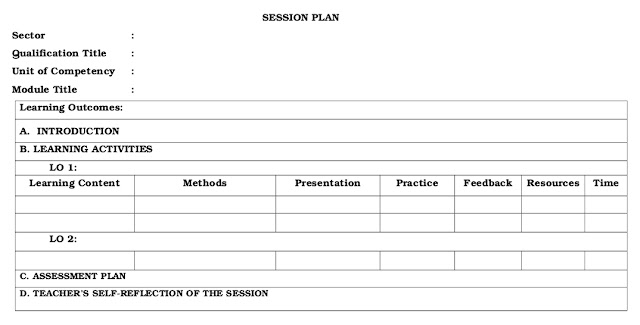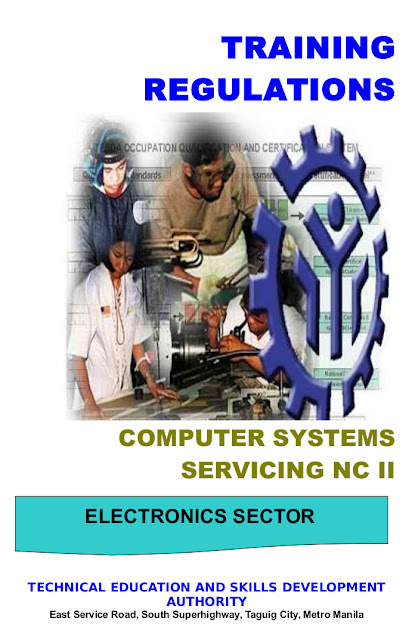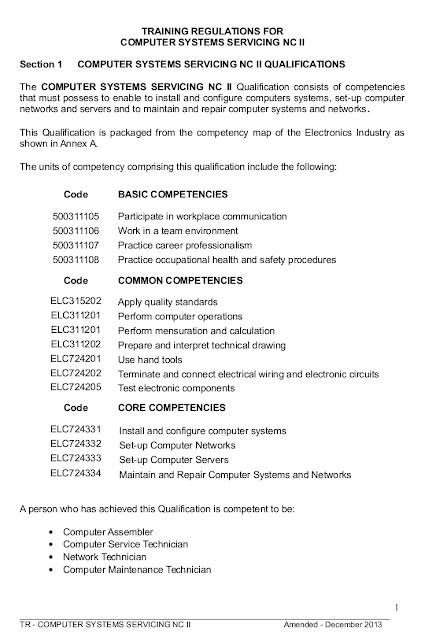Session Plan
In our last tutorials, we had talked about the development of Trainee Characteristic Gathering and Training Needs Analysis Tools. for this next tutorial, I will be taking up the topic of Session Plan.
What you will need:
- A Copy of the Plan Training Session-Competency Based Learning Materials (PTS-CBLM) released by the National TVET Trainers Academy (NTTA), which will serve as our primary source of information;
- a copy of your respective qualification's Training Regulations (TR)s that you can download at the download section of this blog;
- a copy of your reference materials; and
- a copy of the Session plan template that you can download individually here, or should you chose, you can download the entire PTS Zip file at the template section of this blog.
Introduction
The Trainers Methodology Level 1 Core competency Plan Training Session-Competency Based Learning Materials (PTS-CBLM) on page 101, states that the
"Session Plan is a simply stated, clearly written and flexible trainer aid for conducting a session or module." That is "based on the curriculum of the unit of competency; and accomplished according to the suggested format."
Further it states that,
"Generally, the longer the program, the more often it is delivered, and the more complex the curriculum, the more detail is required in the training outline."
"It is important to make the outline as clear and complete as possible so that important points will not be overlooked during the preparation of the trainer guide and the participant materials."
"Regardless of the length and complexity of a training program, if other people will be involved in materials development and delivery, the outline must be written in sufficient detail to communicate to them the designer's intent."
From the same document, it also explains the benefits of a having a Session Plan, and these are:
- Gives the trainers an idea of where they are and where they are going;
- Gives the trainers and the learners a clear idea of what they are doing;
- Records the training sessions the trainers have taken;
- Gives the trainers a starting point if they have to do the training again
- with another learner or group of learners; and
- Gives the trainers a firm base to review their performance.
 |
| Figure 1. Sample Session Plan Template |
- Industry Sector
- Qualification Title and Level
- Unit of Competency
- Module Title
- [Nominal Duration]
- Learning Outcomes
- Introduction
- Learning Activities
- Evaluation
- Teacher’s Reflection
Industry Sector and Qualification Title and Level
- All qualification that the TESDA have promulgated are grouped based
on different industry sector. To know the particular sector of your
qualification, look at the front page, bottom part of your respective
Training Regulation, what follows after the Title of your qualification
is its sector. (Figure 2)
Example:
Qualification Title - Computer Systems Servicing NC-II
Qualification Title - Computer Systems Servicing NC-II
Industry Sector - Electronics
 |
| Figure 2. Front Cover of a Training Regulations (TR). |
Unit of Competency - The Units of Competencies comprise a Qualification and grouped into three, these are the: 1. Basic; 2. Common; and 3. Core Competencies. These competencies can be found under section one of your respective Training Regulations. (Figure 3)
For this example, the basic competencies have four competencies, the Common have seven and finally the core competency have four.
Module Title - as explained in the PTS-CBLM, "This is actually the unit of competency. The difference of the Unit of Competency and the Module Title is, the verb in the module title is in the present participle (ending in –ing) form."
Example:
Unit of Competency: Draft Plumbing Design
Module Title: Drafting Planning Design
Nominal Duration - the nominal duration referred here is the estimated total number of hours that it will need to complete the relative core competency, normally defined by the Competency Based Curriculum (CBC). In the absence of a CBC, you as the Trainer should do the estimation of the nominal duration.
Learning Outcomes (LO)s - learning outcomes refers to the Elements under Section 2 : Competency Standards of your respective Training Regulations.
One will notice that for each Competency, there is a corresponding set of Elements and performance Criteria. (Figure 4) For this example, under the CSS NC-II Core competency Set-up Computer Networks. it's elements are but not limited to: 1. Install Network Cables and 2. Set network configuration, with the rest not shown to conserve on bandwidth.
As for this example, when developing our session plan, these elements are what we refer to as Learning Outcomes, orderly arranged in our session plan.
Note:
- In some instances, the arrangement of the elements in the TR does not coincide on how we intend to deliver the training session. In my humble opinion, being the Certified Trainer who is to deliver the training session, there is nothing wrong if you change its arrangement, change its arrangement as deemed you see fit, just ensure that you will be able justify your design when asked.
Introduction - the unit descriptor (Figure 4) can serve as you introduction in your session plan, you can add more information should you feel it wise to do so.
The PTS-CBLM further explains on page 104,
"This is the part of the session plan that intends to motivate the student to learn. It will acquaint the student to what he/she is:
- going to learn in the module;
- why it is important;
- how it relates to what has already been learned; and
- It is also termed as Module Descriptor in the CBC, [Unit Descriptor in the TR]."
Learning Activities - These refers to the different activities that you intend to use/perform for the delivery of your training program to achieve the desired Learning Outcome.
For the activities, TESDA recommends and follows the Nine Events of Instruction of Robert Gagnes, further explained in the PTS-CBLM on pages 104-105.
The Learning Activities comprises of the following parts (Refer to Figure 1):
- Learning Content
- Presentation
- Practice
- Feedback
- Learning Resources
- Time (optional)
Learning Contents - refers to the contents/topics that you intend to use in order to achieve the desired learning outcomes, normally predefined in a developed Competency Based Curriculum (CBC).
In the absence of a CBC however, you can also utilized your respective Training Regulations for the possible topics/contents that you can use. Worth nothing is that the CBC is a reflection of the Training Regulation, as utilized by the TVET Training Institution in achieving their respective Vision Mission and Objectives.
When using the TR as your guide for your contents, you can refer to the following: 1. Performance Criteria; 2. Range of Variables; and 3. Evidence Guide.
Notes:
- When using the performance criteria, do note that performance criteria normally refers to the desired skills that the Trainee are expected to Perform in regards to the required Learning Outcome. Listed performance criteria is specific to a learning outcome.
- While the contents of the range of Variables and Evidence Guide refers to all the Learning Outcomes. Meaning, the listed possible topics under these two can be used to any Learning Outcomes under that specific core competency.
- If you think that your desired topic cannot be found in any of the three areas, you can create your own topic if it is really needed to ensure that the desired learning outcome is achieved.
PTS-CBLM from pages 105-106 further states that,
"In sequencing contents, the hierarchy of learning should be taken into consideration. Always arrange your contents from simple to complex. Gagne’s hierarchy of learning shows how these skills are arranged from simple to complex."
Methods - the different CBT based Training Methods that a Trainer can use were discussed in full on pages 86-96 on the PTS-CBLM, these methods can be but not limited to the following:
- Lecture
- Role Playing
- Debate
- Group Discussion
- Demonstration
- Forum
- Structured Learning Exercise (SLE)
- Buzz Group
- Practice
- Brainstorming
- Public Speaking
- Case Study
- Study Circle
- Field Trip
Whatever method that you decide to use for your training delivery it is worth noting of the following as the PTS-CBLM explains.
Guiding principles in method selection
A method suitable in one situation may not be appropriate in another. The value of a method and the quality of tools used depends on how it is applied.
Methods must complement one another.
As cited in the PTS-CBLM, James Bennett-Levy et.al. in their research entitled “Acquiring and Refining CBT Skills and Competencies: Which Training Methods are Perceived to be Most Effective?”[they] found that different training methods were perceived to be differentially effective.
For instance, reading, lectures/talks and modeling were perceived to be most useful for the acquisition of declarative knowledge, while en active learning strategies (role-play, self-experiential work), together with modeling and reflective practice, were perceived to be most effective in enhancing procedural skills.
Self-experiential work and reflective practice were seen as particularly helpful in improving reflective capability and interpersonal skills
Presentation - The PTS-CBLM states that under this column, "the student is presented with ideas, concept or process appropriate for the LO." In other words this is where you write what you intend to do in order to present your lesson/s (selected contents) which refers to the different activities that the trainee needs to go through in order to achieve the desired learning outcome. These activities can be any but not limited to the following:
Reading information sheets, Textbook, references manuals, other on-line resources that can be browsed from the Internet;
Viewing / Watching / listening to Audio/Visual presentations; Observation / demonstration of skills; and or any other activity that you may see do fit that will allow you to properly present your selected topic/content/lesson in a very effective way.
Practice - as explained by the PTS-CBLM under this column, "the student is provided an opportunity to practice or apply the same knowledge or skill that was presented." To simplify, this is where you state the kind of activity that a trainee can perform to practice what the student has recently learned. These activities can be any but not limited to the following:
- Answering Self-checks for knowledge contents
- Solving typical problems
- Hands-on practice of a skill using the Task/job/operation Sheets
- Critiquing case studies
- Answering questions
Task/Job/Operation sheets what are these?
- Task - refers to a single specific activity that a candidate needs to perform.
- Job - refers to a combination or needed multiple task to complete a job.
- Operation - refers to the procedural requirement to operate an equipment.
- Sheet - refers to a required written instructions to perform a task, job or an operation.
Thus a task sheet can be defined as the needed instruction in performing a task, a job sheet is a written instructions on how to accomplish a job, while an operation sheet are the written instructions on how to operate an equipment.
Feedback - under this column, PTS-CBLM states that this where "the student is given immediate feedback on the result of the application of the concept or methods performed is receive coaching from the Trainer/Facilitator if needed." In short, this is where you state the activities that the Trainee needs to undergo to receive an immediate feedback in regards to what the student had recently practiced. These activities can be any but not limited to:
- Checking answers with answer key
- Checking finished product or procedure with detailed checklist.
- Having instructor critique product or performance
Most of the time as per PTS-CBLM,
"This activity is supported with Answers Keys , Procedural Checklist and Performance Criteria Checklist"
Time - time in this regard refers to a nominal time, an estimate on how long an activity is to be accomplished by the trainee. PTS-CBLM also explains that,
"Since the approach of the learning is self-paced, time or duration of the training is not a MUST. However, a Trainer/facilitator can opt to identify the time or duration of the training as a basis to identify whether the trainee is a slow or fast learner."
For this particular output, it is highly advisable that you as a TM Trainee, to include the estimated nominal duration for each activity so that you can fully estimate if the overall activity that you have designed for a particular training meets the stated Nominal Duration for the entire core competency.
Figure 5. Sample Session Plan, with complete learning activities
Referring to Figure 5, the provided sample was designed for CSS NC II, worth noting is that the Learning Outcomes were limited to two, and the entire learning activity, although sequenced and complete per activity were insufficient to cover the entire requirements of this core competency. this particular session plan was specifically designed as a working sample for this topic and for explanatory purposes only.
To summarized the learning activities for the sample session plan in fig. 5.
There are two learning contents for this sample, these are Content No.1 network basics and Content No. 2 Peer Networks.
Content No 1 is to be taught using Lecture / Discussion method. To present this topic, the Trainees will be required to read information sheet 1.1.1 Network basics from their CBLM. Lecture/Discussion shall follow immediately after the Trainees have read the info sheet. After the Lecture/discussion, the Trainees will be required to answer self check 1.1.1 Network Basics, immediate feedback follows after the self check by checking their answers with answer key 1.1.1 Network basics. This entire activity is expected to be finished within 30mins.
I will be leaving up to you to explain how content no 2 is to be taught, if you are the Trainer for this topic, how will you deliver the Training Session is something that you need to think about. By the time that you can fully explain how to deliver content no 2, I certainly believe that you already understand what a Session plan is all about.
Evaluation / Assessment Plan - the PTS-CBLM explains,
"This indicates the method of evaluating the achievement of the Learning Outcome. Assessment [can] be: Formative - This is a form of progress checks for every Learning Outcome. Progress check can be conducted through written tests or practical test Summative - This is a form of evaluation given at the end of the module. This can also be conducted through written and practical tests"
Further it states that,
"In preparing the ASSESSMENT PLAN, indicate the:
Testing condition - "what are the tools, equipment and supplies and materials that will be needed; Venue of the evaluation; Type of assessment -written test, practical test; and Type of evidence: For written tests: answer sheets; For Practical Tests: Training outputs (project, products), etc."
Trainer / Teachers Reflections
"This part of the Session Plan serves as the documentation of the conduct of the training on a unit of competency.
Highlights of the use of the CBLM must be recorded/documented and must be considered in the validation/improvement of the manual."
Factors to be considered in the documentation:
"Successful moments or events experienced throughout the learning process Feedback from the learners/trainees regarding the use of the CBLM Result of the Evaluation
Areas like sufficiency of learning content, appropriateness of learning and evaluation methodology, well-maintained training facilities, capacity of the Trainer to facilitate the training, sufficiency of learning resources and other factors related to the conduct of the training shall be recorded which shall serve as a basis for review, evaluation and improvement of the session plan"
This ends our brief for this particular output requirements, should you have further questions, feel free to comment below.
Cheers!



No comments:
Post a Comment